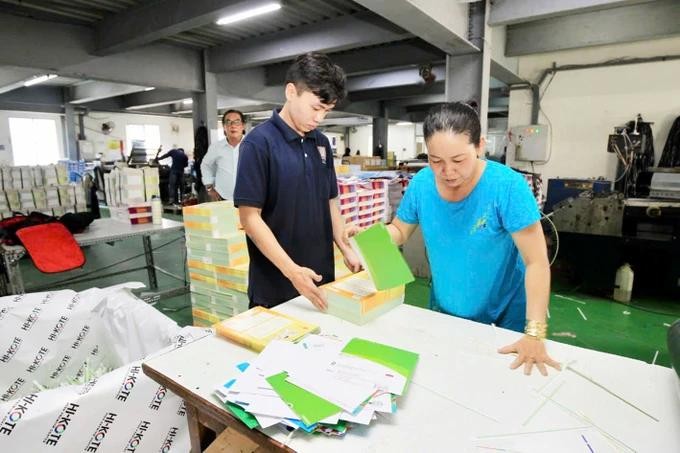
The printing industry has long dominated the publishing, printing, and distribution sector in terms of revenue. However, the printing industry in Ho Chi Minh City has seen its market share decline from 65 percent over a decade ago to just 50 percent today.
In a recent workshop on “Digital capacity framework for the printing industry” organized by the Department of Information and Communications of Ho Chi Minh City, President of the Ho Chi Minh City Printing Association Associate Professor Ngo Anh Tuan pointed out that in the past, the field of publication printing accounted for 65 percent-70 percent of the printing industry whereas this current figure is only over 10 percent.
The world printing industry has long been divided into three distinct segments with different management policies including publication printing, commercial printing, and industrial printing. Meanwhile, Vietnam has just had management policies with a main focus on managing publication printing.
The printing industry in Ho Chi Minh City is struggling to develop due to the decline of the publishing sector and just over 10 percent of the overall industry is under the state management. Meanwhile, the commercial and industrial printing sectors continue to be inadequately supported, as there are no specific policies in place to foster their expansion. This deficiency is the main factor contributing to the overall stagnation of growth within the printing industry, as noted by Associate Professor Ngo Anh Tuan.
Chinese companies are shifting their production factories to Vietnam, but the government has yet to implement specific support policies for the industrial printing sector. As a result, with the exception of export-oriented enterprises, the majority of Vietnamese printing businesses lack the capacity to capitalize on the shift in manufacturing volume from China to Vietnam, leading to a significant waste of opportunities.
The production structure of the printing industry is gradually shifting from Ho Chi Minh City to Binh Duong and Dong Nai provinces to serve the industrial production needs in the two southern provinces. In the North, many large factories from China have also opened, creating great opportunities for industrial printing units to develop strongly. If there is no quick change, the city's printing industry will face the risk of being pushed out of this industrial printing market, said a member of the Ho Chi Minh City Printing Association.
Many experts believe that the printing industry in the country in general and Ho Chi Minh City in particular are taking advantage of good opportunities such as Vietnam has signed and is participating in 19 bilateral and multilateral Free Trade Agreements (FTAs) with most economies in the world.
In addition, the printing industry is considered a supporting industry with its presence in most industries, almost every product has the imprint of the printing industry. Deputy Director Nguyen Ngoc Hoi of the Department of Information and Communications of Ho Chi Minh City said that there is still a lot of room for the development of the printing industry in the southern largest city.
To transform this developmental potential into real advantages, the printing industry in Ho Chi Minh City must engage with the global market. As a sector classified as supportive industry, it is essential for the printing industry to establish its presence within the global printing supply chain in order to expand its reach internationally, stated Mr. Nguyen Ngoc Hoi.
Specifically, Deputy Director Nguyen Ngoc Hoi indicated that in the near future, the Ho Chi Minh City Department of Information and Communications will facilitate opportunities for the city Printing Association to participate in regional and international fairs and exhibitions with the aim to gradually promote and showcase the city's printed products to partners in the globe.
Deputy Director Nguyen Ngoc Hoi emphasized the need for digital and green transformation in the printing industry. He noted that Vietnam's printing industry currently ranks fourth in Southeast Asia, highlighting the urgent need for modernization and innovation to remain competitive on a global scale.
Not only participating in the digital transformation, but it is currently mandatory that the printing industry ought to participate in green transformation to have the opportunity to access the open and potential market for mutual development.
Explaining this, Associate Professor Ngo Anh Tuan said that green transformation is part of the theme of sustainable development. In his opinion, Vietnam must ensure two factors including continuous innovation of production technology to make products with low cost and consume less energy than other businesses.
In addition, from 2024, in order to cooperate with international enterprises, the printing industry will also be forced to comply with strict requirements on environmental protection.
Associate Professor Ngo Anh Tuan highlighted the Prime Minister's approval of the National Strategy on Green Growth, emphasizing the imperative for enterprises to reduce greenhouse gas emissions in accordance with the outlined roadmap.
He underscored that foreign organizations will evaluate potential partnerships based on adherence to this strategy. Therefore, to successfully collaborate with international entities, Vietnamese businesses must minimize their environmental impact throughout the production process and adopt modern equipment and machinery to optimize energy efficiency and promote environmental sustainability.
























